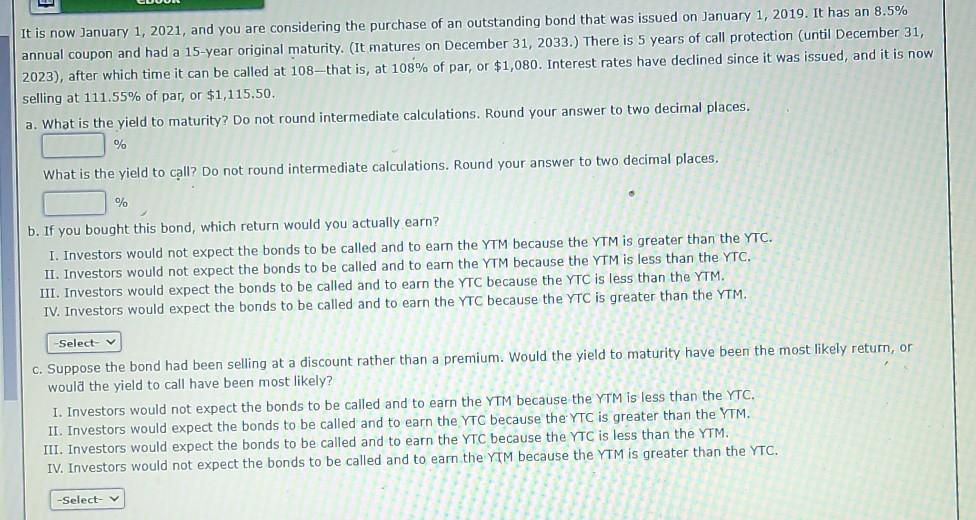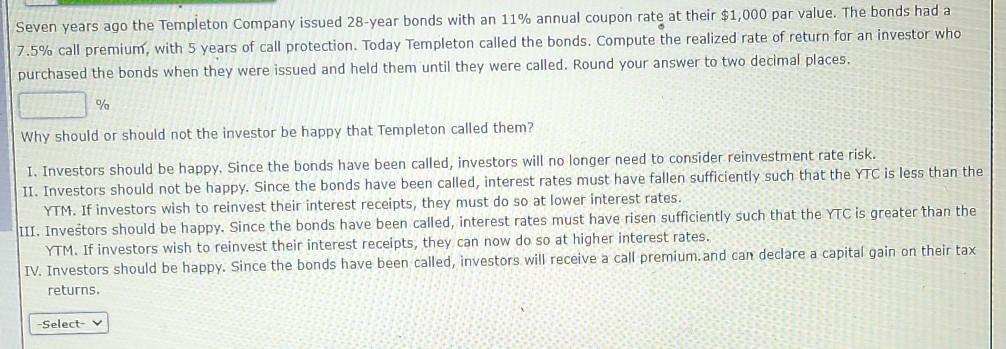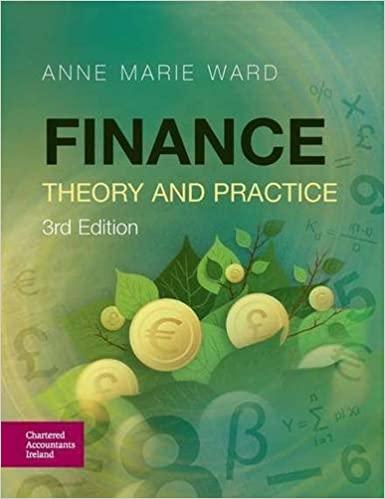Answered step by step
Verified Expert Solution
Question
1 Approved Answer
7 # 10 7#8 It is now January 1, 2021, and you are considering the purchase of an outstanding bond that was issued on January

7 # 10

7#8
It is now January 1, 2021, and you are considering the purchase of an outstanding bond that was issued on January 1, 2019. It has an 8.5% annual coupon and had a 15-year original maturity. (It matures on December 31, 2033.) There is 5 years of call protection (until December 31, 2023), after which time it can be called at 108-that is, at 108% of par, or $1,080. Interest rates have declined since it was issued, and it is now selling at 111.55% of par, or $1,115.50. a. What is the yield to maturity? Do not round intermediate calculations. Round your answer to two decimal places. % What is the yield to call? Do not round intermediate calculations. Round your answer to two decimal places. % b. If you bought this bond, which return would you actually earn? I. Investors would not expect the bonds to be called and to earn the YTM because the YTM is greater than the YTC. II. Investors would not expect the bonds to be called and to earn the YTM because the YTM is less than the YTC. III. Investors would expect the bonds to be called and to earn the YTC because the YTC is less than the YTM. IV. Investors would expect the bonds to be called and to earn the YTC because the YTC is greater than the YTM. -Select C. Suppose the bond had been selling at a discount rather than a premium. Would the yield to maturity have been the most likely return, or woula the yield to call have been most likely? I. Investors would not expect the bonds to be called and to earn the YTM because the YTM is less than the YTC. II. Investors would expect the bonds to be called and to earn the YTC because the YTC is greater than the YTM. III. Investors would expect the bonds to be called and to earn the YTC because the YTC is less than the YTM. IV. Investors would not expect the bonds to be called and to earn the YTM because the YTM is greater than the YTC. -Select Seven years ago the Templeton Company issued 28-year bonds with an 11% annual coupon rate at their $1,000 par value. The bonds had a 7.5% call premium, with 5 years of call protection. Today Templeton called the bonds. Compute the realized rate of return for an investor who purchased the bonds when they were issued and held them until they were called. Round your answer to two decimal places. % Why should or should not the investor be happy that Templeton called them? I. Investors should be happy. Since the bonds have been called, investors will no longer need to consider reinvestment rate risk. II. Investors should not be happy. Since the bonds have been called, interest rates must have fallen sufficiently such that the YTC is less than the YTM. If investors wish to reinvest their interest receipts, they must do so at lower interest rates. III. Investors should be happy. Since the bonds have been called, interest rates must have risen sufficiently such that the YTC is greater than the YTM. If investors wish to reinvest their interest receipts, they can now do so at higher interest rates. IV. Investors should be happy. Since the bonds have been called, investors will receive a call premium.and can declare a capital gain on their tax returns. -SelectStep by Step Solution
There are 3 Steps involved in it
Step: 1

Get Instant Access to Expert-Tailored Solutions
See step-by-step solutions with expert insights and AI powered tools for academic success
Step: 2

Step: 3

Ace Your Homework with AI
Get the answers you need in no time with our AI-driven, step-by-step assistance
Get Started


